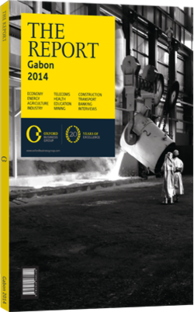Despite its vast potential, hydroelectric generation still takes second
Having a large hydroelectric generation base is a boon to Gabon, giving it low-cost renewable energy. It is hydrocarbons, however, that continue to power most of the country’s plants. According to the most recent statistics available from the US Energy Information Administration (EIA), from 2011, non-renewable thermal energy sources top hydroelectricity, which produced 45.7%, or 809 GWh of the 1769 GWh generated that year. The rest came from gas (584 GWh), oil (367 GWh) and biofuels (9 GWh), with no significant output from coal, peat, waste, solar, wind, tidal or nuclear sources. In 2013, the World Energy Council estimates that non-hydropower renewables such as solar and wind made up just 0.4% of total generation.
Especially in cities, Gabon has a fairly high electrification rate – no easy achievement in Central Africa. The government diversification plan, however, is increasing the burden on the country’s networks. In 2011, industrial activities consumed 358 GWh, just over 20% of the total electricity generated, yet the demand from industry has risen sharply and will continue to do so given the country’s focus on developing domestic value-added manufacturing and processing of raw materials. To reach its goals for industrialisation, Gabon must both increase and diversify its power supply.
Strategy
In the industrial pillar of the government’s Emerging Gabon development plan, the target for energy generation is 5000 MW by 2016, more than double current capacity. To achieve this, the government intends to develop hydroelectric capacity further, tap the country’s natural gas reserves, and promote broader use of renewables. “The goal is to achieve 100% hydroelectric, as opposed to thermal, generation,” said Yvette Poutha, the director-general of energy at the Ministry of Energy and Water Resources. “Hydroelectric power is easier to maintain, it’s cheaper and cleaner, and it’s renewable.” The second priority is gas. Given the country’s roughly 28.3bn cu metres of proven natural gas reserves, Gabon can rely gas as a primary source in the near term and as a secondary one in the long term.
New Power Plants
In 2013, construction finished on three new power plants – two thermal and one hydroelectric – that will supply key processing sites in the timber, oil and manganese industries. The Alénakiri thermal power plant, inaugurated in August 2013, was built by Israeli firm Telemenia at a cost of CFA65bn (€97.5m). Located just outside Owendo, the suburban site of Libreville’s port, the plant’s 70-MW capacity supplies both the capital, the suburbs and the special economic zone (SEZ) in nearby Nkok. The second new thermal plant, also built by Telemenia, has a capacity of 105 MW and supplies the Mandji Island SEZ as well as oil and gas activities in Port-Gentil, where it is located. Both new plants run principally on natural gas, supplied by oil and gas operator Perenco at a combined level of 680,000 cu metres per day, with oil serving as a secondary fuel source. The third project is the 160-MW-capacity hydroelectric power plant, which forms part of the new Grand Poubara dam complex located on the Ogooué River, 15 km from Franceville. Built by China’s Sinohydro with financing from the China Exim Bank, the project is now in the testing phase. About two-thirds of the electricity generated will serve the ferromanganese factory in Moanda, while the remainder will boost the supply of Franceville, which is already serviced by one of the three regional grids.
Hydropower Potential
Gabon’s abundance of inland streams and lakes are an enormous potential source of hydropower, estimated at 5000-6000 MW. Nevertheless, the sector remains underdeveloped. “Hydropower has in recent years declined as a source of electricity generation, largely due to the challenges of financing and managing the necessary infrastructure,” said Poutha. This decline is also the result of poor coordination between sector actors and mismanagement of existing infrastructure, leading to a heavy reliance on thermal power. Currently, there is a need to map extant water sources both above and below ground, and to overhaul the institutional framework governing the sector to clarify roles and responsibilities.
You have reached the limit of premium articles you can view for free.
Choose from the options below to purchase print or digital editions of our Reports. You can also purchase a website subscription giving you unlimited access to all of our Reports online for 12 months.
If you have already purchased this Report or have a website subscription, please login to continue.

